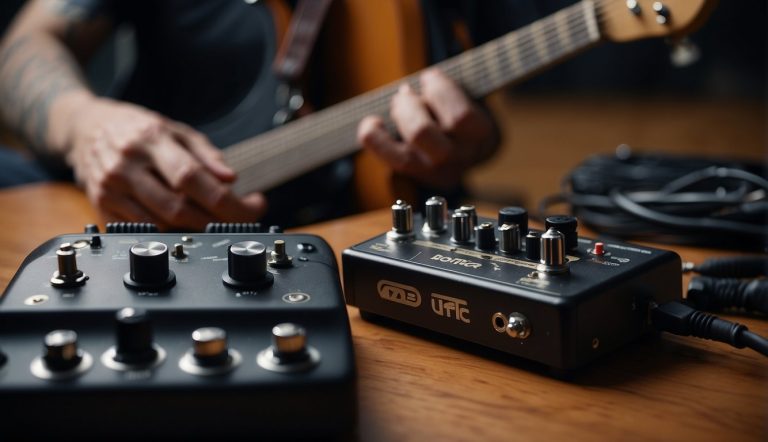What is Absolute Phase in Acoustics and Electrical Engineering?
In the realm of power systems and audio engineering, the concept of absolute phase is crucial.
Absolute phase refers to the consistent reference of a waveform’s cycle compared to a specific standard, allowing for precise phase measurements across systems.
In power system applications, this ensures the coordination of protective relays and synchronization of power grids. The integrity of the electrical infrastructure heavily relies on accurate phase alignment.

In audio systems, understanding and managing absolute phase is equally important, as it affects the sound’s imaging and fidelity.
When the phase relationship between various components of a sound system is not managed properly, it can lead to distortions or cancellations, degrading the listening experience. As we strive for high-fidelity sound reproduction, maintaining the correct absolute phase becomes a foundational aspect of system design and setup.
Key Points
- Absolute phase is critical for both power systems and audio engineering.
- Proper phase alignment is essential for the integrity of electrical infrastructures.
- Correct absolute phase contributes to high-fidelity sound reproduction.
Table of Contents
Fundamentals of Phase in Sound
In my exploration of sound, I have come to understand that phase, and more precisely, absolute phase, are central to the behavior of audio waves.
Understanding Phase and Absolute Phase
Phase refers to the position of a point in time on a waveform cycle. When I talk about absolute phase, I’m referring to the precise measurement of this position within the sound wave cycle, usually expressed in degrees where 360 degrees corresponds to one full cycle. It’s crucial when considering the timing of audio signals, as it can affect the interference patterns created by overlapping sound waves.
The Role of Frequency and Cycle in Phase
Frequency determines how many cycles, or complete waveforms, occur in one second, and this directly impacts the phase.
When discussing multiple sound waves, the relative timing between their cycles determines whether they will constructively or destructively interfere with one another. A cycle is the journey of a wave from zero amplitude to its peak, down to negative peak, and back to zero.
Understanding the correlation between frequency and phase is essential for audio engineers, especially when trying to preserve the fidelity of recorded sound or manage acoustics in a room. Frequency dictates the speed at which the cycles occur, influencing phase alignment and the overall cohesiveness of the audio experience.
Phase Relationships in Audio Systems
In my examination of audio systems, I’ve found that understanding phase relationships is crucial for both the clarity of sound from speakers and the integrity of audio signal processing. Here’s what I have learned about how these relationships affect the audio experience.
Speakers and Polarity
I’ve noticed that the polarity of speakers is a foundational element that directly impacts sound quality.
When I connect loudspeakers, I ensure that the positive and negative terminals are matched correctly to the corresponding output on the amplifier. This is because the voltage applied to the speaker terminals dictates the direction in which the speaker cone moves.
Inconsistent polarity across speakers, also known as being ‘out of phase’, will lead to sound waves that can cancel each other out, reducing bass response and leading to a hollow or flat sound.
Audio Signal Processing
My experience with audio signal processing has taught me that the phase of audio signals is critical, especially when combining multiple signals or during the recording process.
Within an audio system, phase discrepancies can result from complex digital signal processing tasks.
During processing, I often apply techniques that involve the deliberate shifting of the phase to align with other audio components correctly. Using accurate constant phase elements allows me to perform non-asymptotical phase shifting, which is essential when I need to connect two arbitrary points in a circuit with an arbitrary constant phase shift. This is vital for maintaining the integrity of the signal throughout the processing chain.
Measuring and Analyzing Phase
In the realm of physics and engineering, understanding the phase of a wave is crucial for accurate analysis and device functioning. My focus here is on the precise techniques used to measure phase and the implications of phase shifts.
Phase Measurement Tools
One of the primary instruments I use for phase measurement is an oscilloscope. This versatile device not only allows us to visualize waveforms in real-time but also to measure their phase. By comparing the time difference between similar points on a reference wave and the test wave, the oscilloscope can reveal the phase difference between them.
Another essential tool for phase measurement, especially in acoustics, is microphones. By capturing pressure waves, they can provide data which, after proper analysis, indicates the phase of sound waves.
Phase Shift and Its Effects
Phase shift describes the change in phase between two points in time or space. To explain this, consider a sine wave moving through a medium. If the wave encounters an obstacle or change in the medium’s properties, parts of the wave might speed up or slow down, leading to a phase shift.
A phase shift can significantly impact systems that rely on synchronization. For instance, in wireless communications, a phase shift might cause signal cancellation or reinforcement, altering the perceived signal strength.
In audio technology, phase differences between microphones can cause constructive or destructive interference, affecting sound quality and clarity.
By understanding how to measure phase and the effects of phase shift, I can effectively analyze and troubleshoot systems that are sensitive to phase alignment, whether it’s in electronic circuits, mechanical systems, or audio technologies.
Phase in the Context of Sound Reproduction
In sound reproduction, the concept of phase is pivotal in ensuring that audio is recorded and played back as it was intended. Proper management of phase relationships can greatly enhance the fidelity of the audio experience.
Importance in Recording and Playback
When I record audio, my goal is to capture the sound waves in a manner that preserves their original phase relationships.
This is crucial because inaccurate phase alignment can cause phase cancellation, where certain frequencies might nullify each other out, leading to a hollow or flat sound during playback.
Audiophiles, in particular, appreciate the nuanced sounds that accurate phase reproduction provides. For instance:
- Complete Phase Alignment: All audio elements are in sync, delivering sound that is rich and full.
- Phase Misalignment: Leads to certain sounds canceling each other or sounding disjointed.
In multi-track recordings, I ensure each track is in relative phase to produce a coherent sound. This phase coherence is also vital during sound reproduction, where speakers or headphones must translate these phase relations accurately to the listener.
Perceived Phase Effects on Audio Quality
The perception of audio quality is influenced by the phase characteristics of sound reproduction.
In listening tests, I observe how individuals may experience a difference in the spatial representation and depth of sound based on the phase alignment.
It’s not uncommon for two tracks, identical in content but different in phase, to be subjectively evaluated as varying in quality by listeners. Consider the following effects:
- In-phase signals: Lead to a sound perceived as robust and well-defined.
- Out-of-phase signals: May cause a diffuse or weak sound image, impacting the listener’s immersion.
Therefore, maintaining phase integrity from recording to playback is essential for an authentic and high-quality audio experience. I pay close attention to phase coherency in my work to ensure listeners receive the closest representation of live sound.
Conclusion

In the realm of absolute phase, the nuances are critical, impacting both the quality of audio experiences and the progression of phase-related research.
Implications for Audio Practices
My research indicates that absolute phase, a concept often debated among audiophiles, plays a significant role in the fidelity of audio reproduction. When assessing the integrity of acoustic signals, ensuring absolute phase alignment is crucial.
This precaution is supported by listening tests that suggest discrepancies in phase can distort the soundstage, affecting the listener’s experience.
Future Directions in Phase Research
Looking ahead, the field of application for absolute phase research extends into audio engineering and signal processing.
I anticipate a surge in innovative methodologies geared toward more precise phase measurement and correction, potentially revolutionizing how professionals conduct phase adjustments and set standards within the industry.
Frequently Asked Questions
In this section, I discuss the nuances of absolute phase and how it applies to various fields of physics and engineering.
How do absolute phase and relative phase differ in physics?
Absolute phase refers to the precise measurement of the position of a wave at a specific instance, whereas relative phase describes the difference in positions between two waves or a wave and a reference position at a given time.
Can you explain the formula used to determine absolute phase?
The formula for determining absolute phase often involves the use of mathematical models capturing the wave’s propagation, where the phase is typically represented by the angle in a periodic function, such as (\phi = 2\pi ft + \theta), with (f) being the frequency, (t) time, and (\theta) phase offset.
What are the implications of absolute phase in scholarly literature?
In scholarly texts, understanding absolute phase is crucial for precision measurements in various scientific research areas, particularly in optimizing the accuracy of satellite and receiver antenna systems within global positioning technologies.
How does phase relate to signal processing?
In signal processing, phase is a fundamental concept indicating the state of an oscillation within a cycle and is used to analyze waveforms, synthesize signals, and process digital data streams.
In what way does phase shift affect physical oscillations?
Phase shift in physical oscillations results in the displacement of a wave in time or space compared to a reference signal, which can cause constructive or destructive interference patterns important in acoustics, optics, and electronic circuits.
How is phase angle defined in the context of absolute phase?
Phase angle in the context of absolute phase is defined as the specific degree position of a point within a wave cycle, typically measured in radians or degrees from a fixed point such as the origin of the wave or a significant event like the zero crossing.






